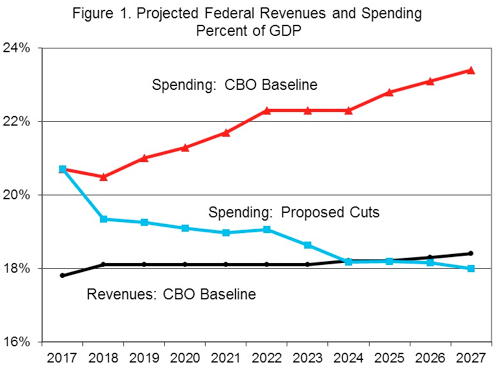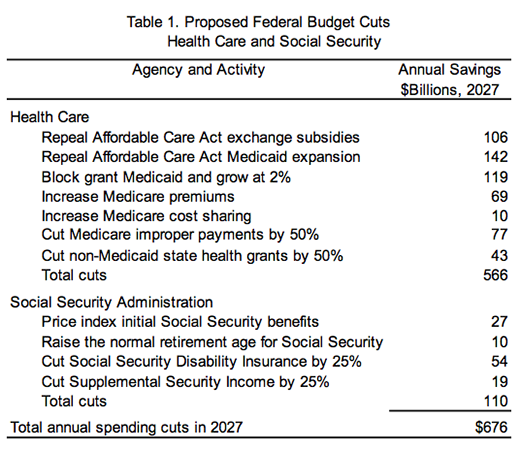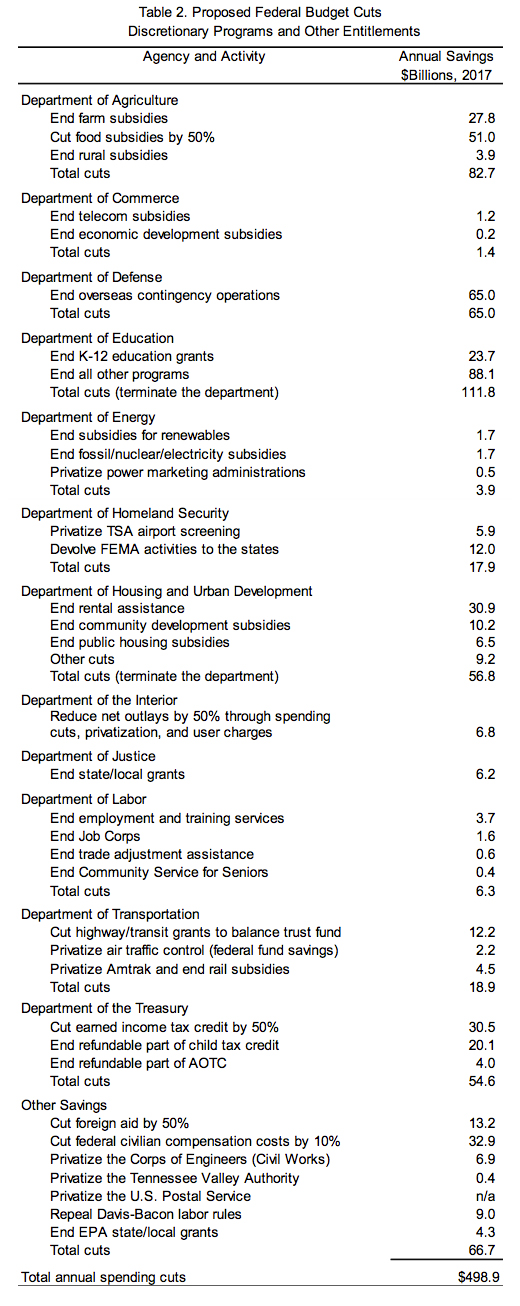Federal government spending is rising, deficits are chronic, and accumulated debt is reaching dangerous levels. Growing spending and debt are undermining economic growth and may push the nation into a financial crisis in coming years.
The solution to these problems is to downsize every federal department by cutting the most harmful programs. This study proposes specific cuts that would reduce federal spending by almost one-quarter and balance the budget in less than a decade.
Federal spending cuts would spur economic growth by shifting resources from lower-valued government activities to higher-valued private ones. Cuts would expand freedom by giving people more control over their lives and reducing the regulations that come with spending programs.
The federal government has expanded into many areas that should be left to state and local governments, businesses, charities, and individuals. That expansion is sucking the life out of the private economy and creating a top-down bureaucratic society that is alien to American traditions. So cutting federal spending would enhance civil liberties by dispersing power from Washington.
The Congressional Budget Office (CBO) projects that federal spending will rise from 20.7 percent of gross domestic product (GDP) in 2017 to 23.4 percent by 2027 under current law.1 Over the same period, tax revenues are expected to rise much more slowly, reaching 18.4 percent of GDP by 2027. As a consequence, fast-growing spending will produce increasingly large deficits.
Policymakers should change course. They should cut spending and eliminate deficits. The plan presented here would balance the budget within a decade and generate growing surpluses after that. Spending would be reduced to 18.0 percent of GDP by 2027, or almost one-quarter less than the CBO projection for that year.
Some economists claim that cutting government spending would hurt the economy, but that notion is based on faulty Keynesian theories. In fact, spending cuts would shift resources from often mismanaged and damaging government programs to more productive private activities, thus increasing overall GDP. Markets have mechanisms to allocate resources to high-value activities, but the government has no such capabilities.2
It is true that private businesses make many mistakes, but entrepreneurs and competition are constantly fixing them. By contrast, federal agencies follow failed and obsolete approaches decade after decade.3 So moving resources out of the government would be a net gain for the economy.
Consider Canada's experience. In the mid-1990s, the federal government faced a debt crisis caused by overspending, which is similar to America's current situation. But the Canadian government reversed course and slashed spending from 23 percent of GDP in 1993, to 17 percent by 2000, to just 15 percent today.4 The Canadian economy did not sink into a recession from the cuts as Keynesians would have expected, but instead grew strongly during the 1990s and 2000s.
Thus policymakers should not think of spending cuts as a necessary evil to reduce deficits. Rather, the U.S. government's fiscal mess is an opportunity to make reforms that would spur growth and expand individual freedom. The plan proposed here includes a menu of spending reforms for policymakers to consider. These and other reforms are discussed further at www.DownsizingGovernment.org.
Spending Cut Overview
This section describes how cutting spending would eliminate the federal deficit within a decade and generate growing surpluses after that. The starting point for the plan is the CBO's baseline projection from January 2017.5 Figure 1 shows CBO projections for revenues (black line) and spending (red line) as a percent of GDP. The gap between the two lines is the federal deficit, which is expected to grow steadily without reforms.
 ›
›
The blue line shows projected spending under the reform plan proposed here. Under the plan, spending would decline from 20.7 percent of GDP today to 18.0 percent by 2027. The deficit would be eliminated by 2024 and growing surpluses would be generated after that. Under the plan, spending cuts would be phased in over 10 years and would total $1.5 trillion annually by 2027, including about $225 billion in reduced interest costs that year.6
Falling spending and deficits would allow room for tax reforms. One reform would be to repeal the tax increases under the 2010 Affordable Care Act.7 Another reform would be to slash the federal corporate tax rate from 35 percent to 15 percent, which would match the reformed Canadian rate. Such a cut would spur stronger economic growth and lose little revenue over the long term.8
In sum, the best fiscal approach would be to cut spending and reform the most damaging parts of the tax code. That would end the harmful build-up of debt, expand personal freedom, and generate benefits for all Americans from a growing economy.
Spending Cut Details
Tables 1 and 2 below list proposed cuts to reduce federal spending to 18.0 percent of GDP by 2027. Table 1 shows the cuts for health care and Social Security. These reforms would be implemented right away, but the value of savings would grow larger over time. The figures shown are the estimated annual savings by 2027, generally based on CBO projections.9
Table 2 shows cuts to discretionary programs and entitlements other than health care and Social Security.10 These cuts would be valued at $499 billion in 2017, but the plan assumes that they would be phased in one-tenth each year over the next decade.11
The reforms listed in Tables 1 and 2 are deeper than the savings from "duplication" and "waste" often discussed by federal policymakers. We should cut hundreds of billions of dollars of "meat" from federal departments, not just the obvious "fat." If the activities cut are useful to society, then state governments or private groups should fund them, and those entities would be more efficient at doing so.
The proposed cuts are illustrative of how to start getting the federal budget under control. Further reforms are needed in addition to these cuts, such as major structural changes to Medicare. The important thing is to start cutting as soon as possible because the longer we wait, the deeper will be the debt hole that is dug.
After the tables, proposed cuts to subsidies, aid to the states, military expenses, and entitlement programs are discussed. The final section discusses the privatization of federal activities. Further analyses of the cuts listed here are available at www.DownsizingGovernment.org.


Subsidies to Individuals and Businesses
The federal government funds more than 2,300 subsidy programs, more than twice as many as in the 1980s.12 The scope of federal activities has expanded in recent decades along with the size of the federal budget. The federal government subsidizes farming, health care, school lunches, rural utilities, the energy industry, rental housing, aviation, passenger rail, public broadcasting, job training, foreign aid, urban transit, and many other activities.
Each subsidy causes damage to the economy through the required taxation. And each subsidy generates a bureaucracy, spawns lobby groups, and encourages even more people to demand government hand-outs. Individuals, businesses, and nonprofit groups that become hooked on federal subsidies essentially become tools of the state. They lose their independence, have less incentive to innovate, and shy away from criticizing the government and its failures.
Table 2 includes cuts to subsidies in agriculture, commerce, energy, housing, foreign aid, and other activities. Those cuts would not eliminate all of the unjustified subsidies in the budget, but they would be a good start. Government subsidies are like an addictive drug, undermining America's traditions of individual reliance, voluntary charity, and entrepreneurialism.
Aid to the States
Under the Constitution, the federal government was assigned specific limited powers, and most government functions were left to the states. To ensure that people understood the limits on federal power, the Framers added the Constitution's Tenth Amendment: "The powers not delegated to the United States by the Constitution, nor prohibited by it to the States, are reserved to the States respectively, or to the people." The amendment embodies federalism, the idea that federal and state governments have separate areas of activity and that federal responsibilities are "few and defined," as James Madison noted.
Unfortunately, policymakers and the courts have mainly discarded federalism in recent decades. Through "grants-in-aid" Congress has undertaken many activities that were traditionally reserved to state and local governments. Grant programs are subsidies that are combined with federal regulatory controls to micromanage state and local activities. Federal aid to the states totals almost $700 billion a year, and is distributed through more than 1,100 separate programs.13
The theory behind grants-in-aid is that the federal government can operate programs in the national interest to solve local problems efficiently. However, the aid system does not work that way in practice. Most federal politicians are preoccupied by the competitive scramble to maximize subsidies for their states, regardless of program efficiency or an appreciation of overall budget limitations.
Furthermore, federal aid stimulates overspending by state governments and creates a web of complex federal regulations that undermine state innovation. At all levels of the aid system, the focus is on regulatory compliance and spending, not on delivering quality public services. The aid system destroys government accountability because each level of government blames the other levels when programs fail. It is a triumph of expenditure without responsibility.
Federal aid is a roundabout funding system for state and local activities. It serves no important economic purpose. By federalizing state and local activities, we are asking Congress to do the impossible — to efficiently plan for the competing needs of a diverse country of 320 million people.
The grant-in-aid system should be eliminated. Policymakers should revive federalism and begin terminating grant programs. Tables 1 and 2 include cuts to grants for education, health care, highways, justice, transit, and other activities. There is no reason why such activities should not be funded at the state and local levels.
Military Expenses
Cato Institute defense experts Chris Preble and Ben Friedman have proposed numerous cuts to U.S. military spending.14 They argue that the United States would be better off taking a wait-and-see approach to distant threats, while letting friendly nations bear more of the costs of their own defenses. They note that U.S. policymakers support extraneous missions for the military aside from the basic role of defending the nation.
As such, the military budget should be trimmed in a prudent fashion as part of an overall plan to downsize the government and balance the budget. The current plan assumes that spending on overseas contingency operations — which will be $65 billion in 2017 — would be phased down to zero.
Medicare, Medicaid, and Social Security
The projected growth in Medicare, Medicaid, and Social Security is the main cause of America's looming fiscal crisis. Budget experts generally agree on the need to restructure these programs. The reforms listed in Table 1 include cuts to Medicare, Medicaid, and Social Security.
Policymakers should repeal the 2010 Affordable Care Act (ACA). That would reduce spending on Medicaid and end spending on the exchange subsidies. In addition, policymakers should convert Medicaid from an open-ended matching grant to a block grant, while giving state governments more program flexibility. That was the successful approach used for welfare reform in 1996, which encouraged state innovation. Changing Medicaid to a block grant and capping annual spending growth at 2 percent would save about $119 billion annually by 2027.15
Table 1 includes modest Medicare changes based on CBO estimates.16 Reforms include increasing deductibles and increasing premiums for Part B to cover 35 percent of the program's costs. It also assumes that the Medicare improper payment rate would be cut to half of its current rate.17
However, larger Medicare reforms are needed than just these cuts. Cato scholars have proposed moving to a system based on individual vouchers, personal savings, and consumer choice for elderly health care.18 Such a reform would create strong incentives for providers and patients to improve system quality and reduce costs.
For Social Security, the growth in initial benefits should be indexed to prices rather than wages to slow the program's growth. That reform would save about $27 billion annually by 2027 and growing amounts after that. The plan also includes a CBO option to modestly raise the normal retirement age. In addition, the fraud-plagued Social Security Disability Insurance and Supplemental Security Income programs would be trimmed 25 percent compared to current spending projections.
Privatization
A privatization revolution has swept the world since the 1980s. Following Britain's lead, governments in more than 100 countries have transferred thousands of state-owned businesses to the private sector. More than $3 trillion of railroads, energy companies, postal services, airports, and other businesses have been privatized.19 Governments of both the political right and left have sold off state-owned businesses.
Privatization spurs economic growth. It allows entrepreneurs in competitive markets to reduce costs, improve service quality, and increase innovation. Privatization also benefits the environment by reducing activities that waste resources.
Despite the global success of privatization, reforms have largely bypassed our own federal government. There are many activities that have been privatized abroad that remain in government hands in this country. That creates an opportunity for U.S. policymakers to learn from foreign privatization and enact proven reforms here.
Table 2 includes the privatization of Amtrak, the air traffic control system, airport screening, electric utilities, and the Army Corps of Engineers. Such reforms would reduce budget deficits and improve management. The savings listed in the table stem from the elimination of federal subsidies to these activities.
Consider the nation's air traffic control (ATC) system, which is run by the Federal Aviation Administration. The FAA's modernization efforts have often fallen behind schedule and gone overbudget.20 The ATC system needs major improvements to meet rising travel demands, but the FAA is not up to the challenge.
The solution is to privatize the ATC system and separate it from the government. Canada privatized its ATC in 1996, setting up a private, nonprofit corporation, Nav Canada.21 The company is self-supporting from charges on aviation users. It is one of the safest systems in the world, and has won international awards for its efficient and innovative management.22
Conclusions
Without reforms, projections show that federal spending will consume an increasing share of the U.S. economy in coming years. It seems unlikely that American voters would let the government grow endlessly without demanding major budget changes. Also, to support the projected rise in spending, the government would need to raise taxes substantially. But it is unlikely that taxes could be raised much above current levels because of resistance from citizens and the realities of the global economy.23
Policymakers will have to make large spending cuts sooner or later, and the sooner the better to avoid accumulating more debt. They should begin reforming the government with the menu of cuts presented here. Leaders of other nations have pursued vigorous cost cutting when their debt started getting out of control, and there is no reason why our political leaders cannot do the same.
1 Congressional Budget Office, "The Budget and Economic Outlook: 2017 to 2027," January 2017.
2 Chris Edwards, "Central Planning and Government Failure," DownsizingGovernment.org, Cato Institute, September 2015.
3 Chris Edwards, "Bureaucratic Failure in the Federal Government," DownsizingGovernment.org, Cato Institute, September 2015.
4 Chris Edwards, "We Can Cut Government: Canada Did," Cato Policy Report, Cato Institute, May-June 2012. For the latest data, see www.fin.gc.ca.
5 Congressional Budget Office, "The Budget and Economic Outlook: 2017 to 2027," January 2017.
6 As the deficit was reduced, interest costs would fall. I modeled interest costs using CBO projections. I adjusted for the fact that federal debt held by the public is projected to grow faster in coming years than indicated by the accumulation of annual deficits.
7 ACA tax revenues are about 0.7 percent of GDP annually. See Congressional Budget Office, Letter to Speaker John Boehner regarding H.R. 6079, July 24, 2012.
8 Chris Edwards, "Corporate Tax Cuts: Canada's Experience," Cato at Liberty, Cato Institute, April 21, 2017. And see Chris Edwards, "Corporate Tax Rates and Revenues in Britain," Cato at Liberty, Cato Institute, March 8, 2017.
9 Some of the Medicare and Social Security savings were based on options in Congressional Budget Office, "Options for Reducing the Deficit: 2017 to 2026," December 8, 2016.
10 The figures for Table 2 are mainly sourced from the Budget of the U.S. Government, Fiscal Year 2018, Analytical Perspectives (Washington: Government Printing Office, 2017), Table 26-1. The figures are estimates for fiscal 2017.
11 Note that the values of cuts would be greater in 2027 than in 2017. I have assumed that the values would grow at the same rate as discretionary spending in the CBO baseline.
12 Chris Edwards, "Independence in 1776; Dependence in 2014," Cato at Liberty, Cato Institute, July 3, 2014. For the most recent count, see www.cfda.gov.
13 The number of programs is discussed in Chris Edwards, "Fiscal Federalism," Cato Institute, June 2013, www.DownsizingGovernment.org/fiscal-federalism.
14 Benjamin H. Friedman and Christopher Preble, "A Plan to Cut Military Spending," Cato Institute, November 2010, www.DownsizingGovernment.org/defense.
15 This figure is in addition to the Medicaid savings from repealing the ACA.
16 Some of these are described in Congressional Budget Office, "Options for Reducing the Deficit: 2015 to 2024," November 2014.
17 The current improper payment rate is 11 percent, according to the Centers for Medicare and Medicaid Services.
18 Chris Edwards and Michael Cannon, "Medicare Reforms," Cato Institute, September 2010, DownsizingGovernment.org/hhs.
19 Chris Edwards, "Privatization," DownsizingGovernment.org, July 12, 2016.
20 Chris Edwards, "Privatizing Air Traffic Control," DownsizingGovernment.org, Cato Institute, April 8, 2016.
22 Chris Edwards, "Privatizing Air Traffic Control," DownsizingGovernment.org, Cato Institute, April 8, 2016.
23 In short, as taxes were raised the economy would weaken and the tax base would move abroad. This theme is explored in Chris Edwards and Daniel J. Mitchell, Global Tax Revolution (Washington: Cato Institute, 2008).